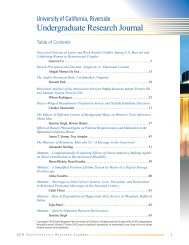UC Riverside Undergraduate Research Journal
UC Riverside Undergraduate Research Journal
UC Riverside Undergraduate Research Journal
You also want an ePaper? Increase the reach of your titles
YUMPU automatically turns print PDFs into web optimized ePapers that Google loves.
Motion Based Bird Sensing Using Frame Differencing and Gaussian Mixture<br />
Deep J. Shah<br />
Introduction<br />
In the past, several background segmentation<br />
techniques have been used to identify the objects of interest<br />
in a scene. The object of interest can be defined as something<br />
that is different in a scene in comparison to previous scenes.<br />
This comparison is performed by comparing a scene with<br />
an object, to an ideal scene which just has the presence of<br />
the background. The regions which observe a considerable<br />
change between the current scene and the previous scenes<br />
are the areas of interest, as they may indicate the location<br />
of the new object.<br />
The term “background segmentation” refers to<br />
identifying the difference between an image and its<br />
background using any of the techniques mentioned in [4]<br />
and then thresholding the results to identify an object of<br />
interest. There are several papers that describe various<br />
methods of performing background subtraction. However,<br />
very few papers describe the algorithms in sufficient detail<br />
to make the re-implementation easy [4].<br />
Hence, this paper thoroughly describes two<br />
background segmentation techniques - frame differencing<br />
and Gaussian mixture. We then investigate the usefulness<br />
and shortcomings of each of these methods in an<br />
environment that involves a constant moving background<br />
due to bird flight, leaf movement, lighting changes, and<br />
other movements in the sky. We try to monitor the birds as<br />
our objects of interest.<br />
Methods: Segmentation Techniques<br />
In the following sections, we describe two approaches<br />
that we use for bird detection. The first section describes how<br />
frame differencing is performed and the second section displays<br />
the framework behind the Gaussian mixture approach.<br />
Frame Differencing<br />
This section describes one of the most common<br />
techniques used in background segmentation. As the name<br />
itself suggests, frame differencing involves taking the<br />
difference between two frames and using this difference<br />
to detect the object. The approach we use is very similar to<br />
this and is a two part process. First, the object is detected<br />
using frame differencing. Then this detected object is<br />
compared with the ground truth to learn the reliability of<br />
this approach.<br />
In our implementation we load two consecutive<br />
frames from a given sequence of video frames. These color<br />
frames are converted to gray scale intensity. Otsu’s Method<br />
[1] is then used to determine the threshold value of the gray<br />
scale images. The threshold value is determined such that<br />
the pixel values on either side of this value are established<br />
to be either a background or a foreground pixel.<br />
Following Otsu’s method, the two consecutive gray<br />
scaled images are differentiated and their absolute difference<br />
is used to identify the movement between frames. The noise<br />
collected due to differencing is removed by applying the<br />
threshold value to the images. The threshold value that we<br />
find in our case varies between [0.43 - 0.45]. Pixels below the<br />
threshold are removed from the differenced frame leaving<br />
behind our object of interest. As described in equation 1, the<br />
absolute difference between two frames needs to be greater<br />
than the threshold for the object to be detected.<br />
| F2 − F1<br />
| > T - (1)<br />
Here F<br />
1<br />
is the initial frame, F2<br />
is the following<br />
frame and T is the threshold value.<br />
Gaussian Mixture<br />
In this section, we describe another technique<br />
that is commonly used for performing background<br />
segmentation. In their paper [5], Stauffer and Grimson<br />
suggest a probabilistic approach using a mixture of<br />
Gaussians for identifying the background and foreground<br />
objects. The probability of observing a given pixel value<br />
p at time t is given by [5]:<br />
t<br />
K<br />
(<br />
,<br />
i=<br />
1<br />
P p t<br />
) = ∑ω i, tη(<br />
pt<br />
, µ<br />
i,<br />
t<br />
, Σi<br />
t<br />
) - (2)<br />
where K is the number of Gaussian mixtures that are<br />
used. The number of K varies depending on the memory<br />
allocated for simulations. The normalized Gaussian η is<br />
a function ofω i, t<br />
, µ<br />
i, t<br />
, Σ<br />
i, t<br />
which represent the weight,<br />
mean, and the covariance matrix of the i th Gaussian at<br />
time t respectively. The weight indicates the influence of<br />
the i th Gaussian at time t. In our case we choose K = 5, to<br />
maximize the distinction amongst pixel values.<br />
Since this is an iterative process, all the parameters<br />
are updated with the inclusion of every new pixel. Before<br />
the update takes place, the new pixel is compared to see<br />
if it matches any of the K existing Gaussians. A match is<br />
48 <strong>UC</strong>R Un d e r g r a d u a t e Re s e a r c h Jo u r n a l














